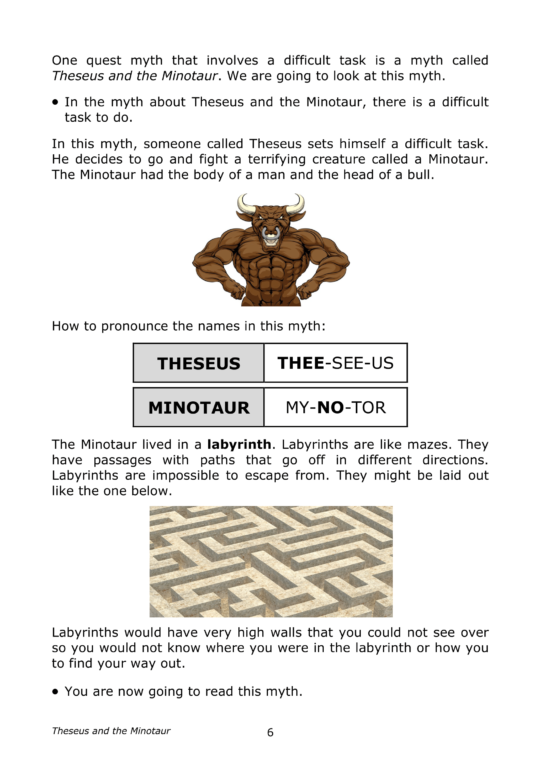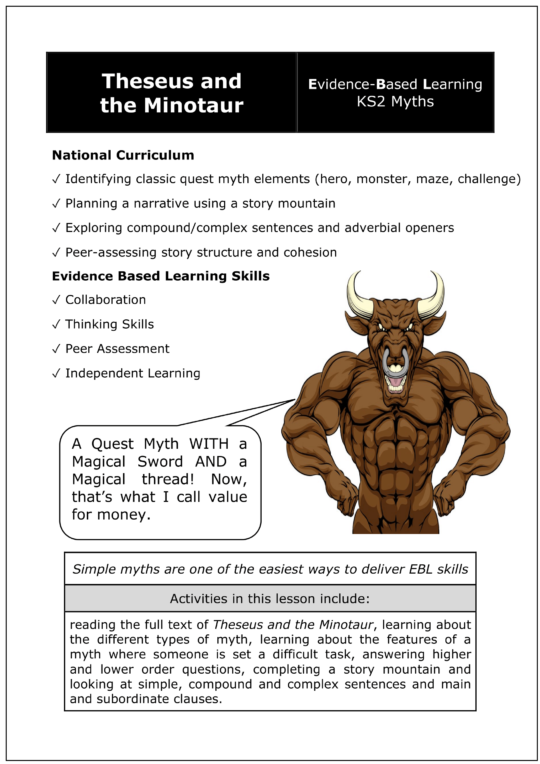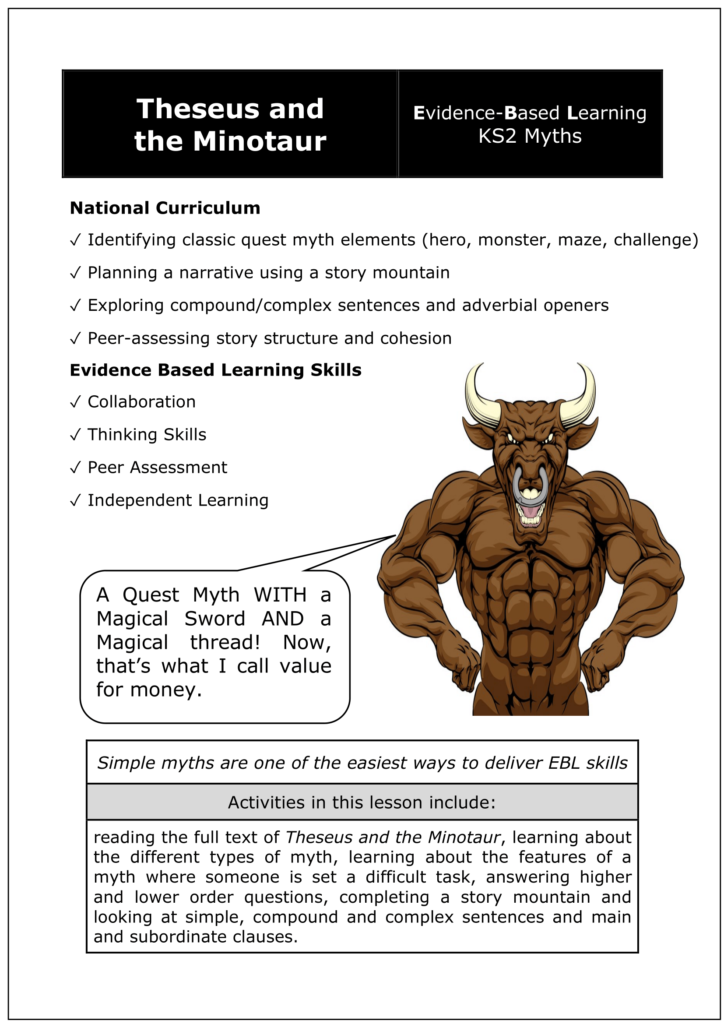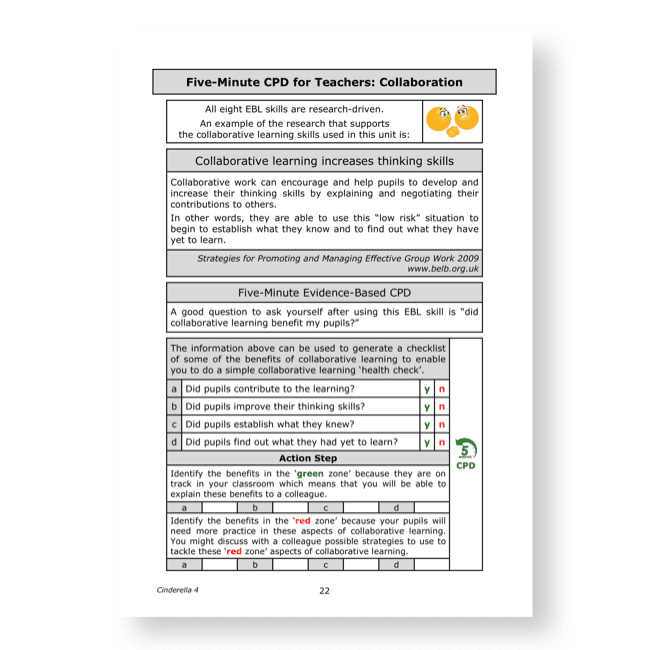Stir this lesson slowly then boil your answers
£3.00
Activities in this lesson include learning about bossy/imperative verbs, adverbs, fronted adverbials and recipes/instructions. Activities also include writing a recipe and writing a spell for Cinderella.
There is a five-minute evidence-based CPD activity at the end of this lesson which will develop classroom teachers’ skill set. This CPD consists of a research extract on collaboration with a five-minute activity based on this extract.
Description
These evidence-based learning (EBL) lessons are based on classroom practice that has been proven, by research, to maximise thinking, learning and attainment. From an extensive review of educational research, we identified the eight key classroom thinking and learning skills that were common across these research papers. We named these eight key skills “EBL skills”.
EBL skills have been proven by research to maximise learning because they combine the most productive thinking skills with the most effective learning behaviours. Each of our evidence-based learning lessons uses the English curriculum as a framework through which the eight EBL skills are delivered.
Teachers also have the opportunity to add to their own skill set or refresh their existing skills with our five-minute CPD activity, based on one of the EBL skills used in this lesson.
The skills in bold below are the EBL skills developed in this Cinderella lesson. Click on each skill to learn more about that skill.
- Collaboration
- Thinking Skills
- Peer Assessment
- Peer Teaching
- Self-Assessment
- Metacognition
- Self-Regulation
- Independent Learning
1 review for Stir this lesson slowly then boil your answers
Only logged in customers who have purchased this product may leave a review.
Related products
-


Y5 The Emperor’s New Clothes (I)
£3.00 Add to basket £3.00Add to basket
£3.00Add to basketKS2 National Curriculum:
✓ Predicting plot events based on character behaviour
✓ Identifying how characters are portrayed through actions and speech
✓ Using group roles to structure discussion and reflection
✓ Writing in response to the text with a focus on clarity and justificationActivities in this lesson include reading the first part of The Emperor’s New Clothes, deciding what will happen next, reading the end of the story, discussing the theme, looking at the four main ways in which characters in stories are described then describing the emperor using these four ways.
There is a five-minute evidence-based CPD activity at the end of this lesson which will develop classroom teachers’ skill set. This CPD consists of a research extract on collaboration with a five-minute activity based on this extract.
VIEW -


Y5 The Golden Age of Piracy
£3.00 Add to basket £3.00Add to basket
£3.00Add to basketKS2 National Curriculum:
✓ Understanding historical facts about galleons, trade, and global routes
✓ Clarifying the setting and context of pirate stories
✓ Extracting information from non-fiction texts
✓ Collaborating with a partner to share and consolidate learning
This lesson introduces the Golden Age of piracy and looks at the use of galleons in the silk trade with China and the spice trade with India. The types of goods that pirates might steal are considered. This lesson also looks at what pirates ate and drank on-board. The activities in this lesson include answering higher and lower order questions and considering whether real pirates had peg legs and eye patches!
There is a five-minute evidence-based CPD activity at the end of this lesson which will develop classroom teachers’ skill set. This CPD consists of a research extract on collaboration with a five-minute activity based on this extract.
VIEW -


Y5 Theseus and the Minotaur
£3.00 Add to basket £3.00Add to basket
£3.00Add to basketKS2 National Curriculum:
✓ Identifying classic quest myth elements (hero, monster, maze, challenge)
✓ Planning a narrative using a story mountain
✓ Exploring compound/complex sentences and adverbial openers
✓ Peer-assessing story structure and cohesionActivities in this lesson include reading the full text of Theseus and the Minotaur, learning about the different types of myth, learning about the features of a myth where someone is set a difficult task, answering higher and lower order questions, completing a story mountain and looking at simple, compound and complex sentences and main and subordinate clauses.
There is a five-minute evidence-based CPD activity at the end of this lesson which will develop classroom teachers’ skill set. This CPD consists of a research extract on collaboration with a five-minute activity based on this extract.
VIEW -


Y5 & Y6 Looking at Dialogue in Treasure Island
£3.00 Add to basket £3.00Add to basket
£3.00Add to basketKS2 National Curriculum:
✓ Recognising the purpose of dialogue in storytelling
✓ Modernising dialogue
✓ Planning and writing a story opening with a stolen mapThis lesson looks at the role of dialogue using an extract from Treasure Island and how to punctuate dialogue. Activities include answering higher and lower order questions as well as writing the opening paragraph of a pirate story after considering three alternative ways of opening the story.
There is a five-minute evidence-based CPD activity at the end of this lesson which will develop classroom teachers’ skill set. This CPD consists of a research extract on collaboration with a five-minute activity based on this extract.
VIEW










Philipem (verified owner) –
We asked a.i. to review this reource. This is what it said:
“Stir this lesson slowly then boil your answers” – Get Creative with Cinderella: Cook Up some Magic
I’ve discovered a brilliant KS2 resource that seamlessly integrates teaching key English skills with developing essential thinking and learning abilities – saving you timetable space. It’s a lesson plan inspired by Cinderella’s fairy godmother and her magical recipes.
🚀 Why this Cinderella lesson works
🌟 Teaches features of instructions and recipes
🌟 Covers grammar points like imperative verbs, adverbs and fronted adverbials
🌟 Develops 4 key evidence-based learning skills: collaboration, thinking skills, metacognition and peer teaching
🌟 Includes a 5 minute CPD activity on the benefits of collaborative learning
The lesson starts by explaining the difference between instructions and recipes, recapping grammar points like imperative verbs. A collaborative thinking skills activity then gets students evaluating recipes and answering higher order questions.
The fun really begins when students write their own magical recipe for Cinderella to use to transform her horrible sisters! This creative writing task is underpinned by prior grammar teaching. Finally, students self-reflect on what they found easy or tricky about writing instructions.
I would give this complete, ready to use lesson 5 stars 🌟🌟🌟🌟🌟 for fully integrating the English curriculum with research-backed learning strategies. The fairy tale context engages students in applying new grammar and writing skills.
I highly recommend this resource for a time-saving way to cover multiple objectives meaningfully.